







Just a head’s up that this week’s “Talk Is Cheap” won’t make much sense to anyone who hasn’t gone to Trent University in Peterborough.
Cheers.












The events depicted in this comic are as recent as last Friday (January 15, 2016). We wrote, drew, inked, and did layout within 48 hours, in time for Savannah’s Martin Luther King parade, in which the Poor People’s Campaign participated.
This comic and others are viewable on our Patreon Page, where we are collecting pledges to continue doing this work.

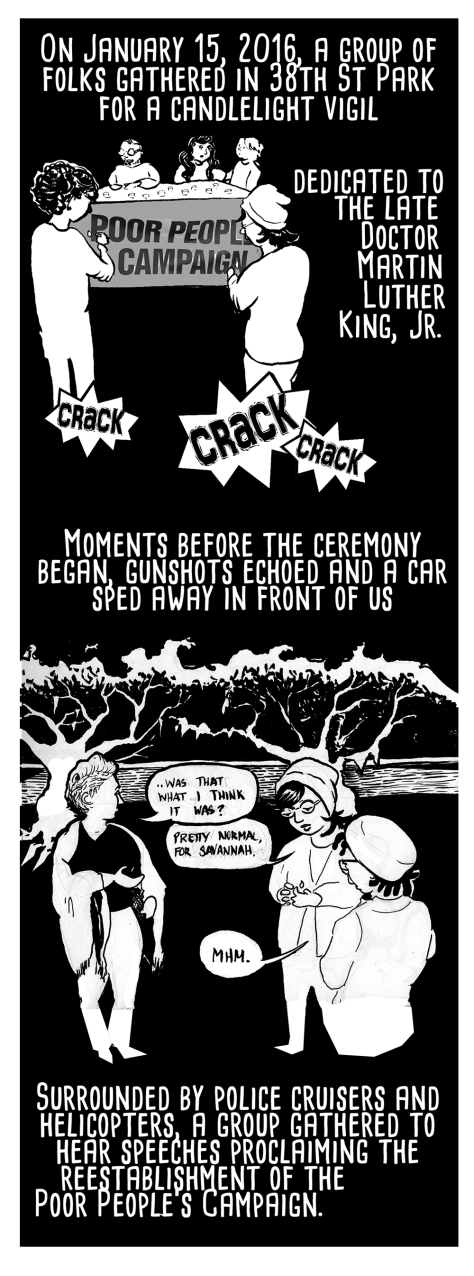


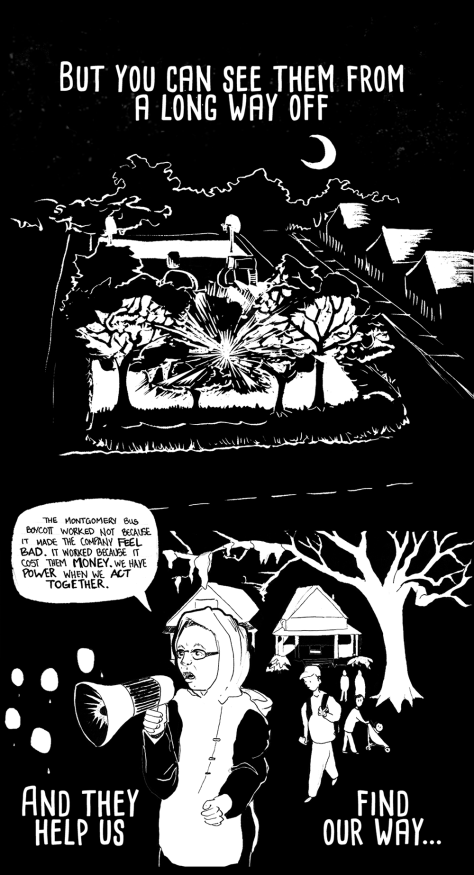
This comic is first of a series of interviews we are doing as we travel across North America. If you’d like us to visit your town, e-mail us.
If you’d like to show your support, we have a Patreon account where you can donate as little as $1 a month to help our work. All of our comics are free to view online.





We’ve decided, in cooperation with the gracious editors at Arthur Newspaper, to release this episode of #TalkIsCheap early. Neither #Paris nor #Peterborough is alone in seeing fear turn to hatred.

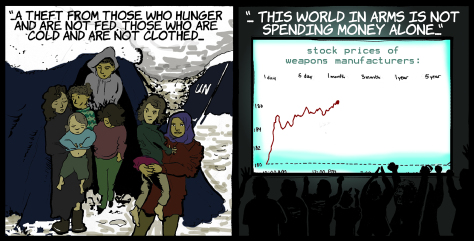


Well, it’s the first week of November. I don’t know about any of you, but I’m always late to the punch for Halloween, preparing a costume, organizing parties and such. If you love Halloween as much as I do, it’s a tragedy that calls for remedy every September. Well, if you’re looking for a spooky piece of history to read about in the lead-up to next year’s All Hallows Eve, consider reading ‘Witch Hunts: A Graphic History of the Burning Times’.

Title: Witch Hunts: A Graphic History of the Burning Times
Author: Rocky Wood, Lisa Morton
Illustrator: Greg Chapman
Publisher: McFarland, 2012
Pages: 185 pages,
ISBN: 978-0786466559
Dimensions: 7.25” x 11.25”
The ‘Burning Times’. Just this phrase sends a shiver up my spine. It’s difficult to believe that, from the 15th to 18th centuries, hundreds of thousands of Europeans, mostly women, were condemned to death for the more-or-less imperceptible crime of witchcraft (exact numbers are disputed). This graphic history is an accessible look at the era, offering anecdotal evidence for a lot of good starting points for further reading.
The book is divided into many short chapters: 1) Before the Trials, 2) The Trials Begin 3) The First Witch Hunter, 4) The Contagion Spreads, 5) Joan of Arc, 6) The Trial of Arras, 7) The Hammer of Witches, 8) Witchcraft and the Reformation, 9) The Trials in Würzburg, 10) King James and the North Berwick Trials, 11) Matthew Hopkins, 12) Witchfinder General, Salem Witch Trials, and 13) The Frenzy Fades.
Perhaps the breadth of this book is its greatest shortcoming; history is a difficult subject to abridge, and even more challenging to illustrate. But the author and illustrator do their best to give us a basic synopsis of everything, as opposed to an in-depth look at any one time or place.
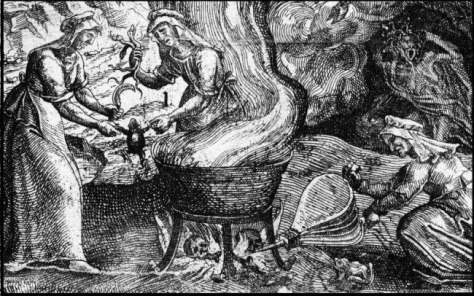 The backdrop of this period was one where political and economic opponents would use the fledgling structures of ‘law and order’ and the ignorance of a population as the stage for their power plays. The book opens with a compelling example, pre-trials: the burning of the Knights Templar in 1314. King Philip the IV of France owed this wealthy organization a great deal of money, but had successfully condemned them to the stake with charges nearly impossible to prove: idolatry, heresy, and sorcery. In Jews, Muslims, pagans, and even uncooperative Christians, men of courts and men with connections found infinite ways to scapegoat these “others” in dark and difficult times.
The backdrop of this period was one where political and economic opponents would use the fledgling structures of ‘law and order’ and the ignorance of a population as the stage for their power plays. The book opens with a compelling example, pre-trials: the burning of the Knights Templar in 1314. King Philip the IV of France owed this wealthy organization a great deal of money, but had successfully condemned them to the stake with charges nearly impossible to prove: idolatry, heresy, and sorcery. In Jews, Muslims, pagans, and even uncooperative Christians, men of courts and men with connections found infinite ways to scapegoat these “others” in dark and difficult times.

In Medieval Europe, the most common “others” were women. Women served a number of roles that were unknown to most men: the midwife, prostitute, and herbalist were all relatively common vocations. Healing was a craft that was passed down from women in families and communities for generations, and served a community need. As time passed and private land ownership overtook The Commons, a woman who was widowed would inherit her husband’s lands, doing with them what she wished. Even in these very limited realms, women were granted a certain amount of power and reverence in society.
As men took various stations within Church and state, many found ways to usurp the authority of women in these traditional roles through what became known as the Witch Hunts, or Burning Times. Women were blamed for premature deaths, plagues, and failed crops. They played on locals’ greatest fears, which were were impossible to disprove. In turn, midwives and herbalists would be replaced by male doctors or “barbers”, landholding widows could be removed, their land parceled between Church and state. It became a veritable gold rush of opportunity, in a time when misogyny allowed such distrust and outright contempt for women of a community.
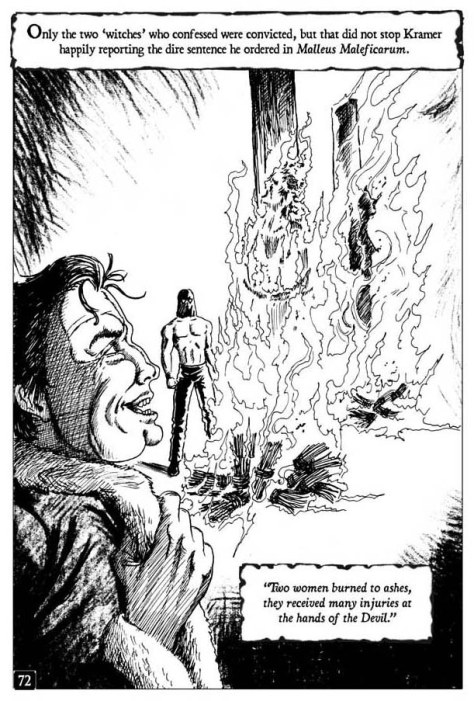 But ignorance can take on a life of its own, in time. As the book explains, the Catholic Church outright denied the existence of witchcraft for some time. This required Witch Hunters to make their accusations and arguments on grounds of heresy, or demon worship. Still, belief in witchcraft spread until the Church and its adherents took a more committed position. This was manifested in the works of Heinrich Kramer, a witch hunter and the author of Malleus Malificarum, or “The Witch’s Hammer”.
But ignorance can take on a life of its own, in time. As the book explains, the Catholic Church outright denied the existence of witchcraft for some time. This required Witch Hunters to make their accusations and arguments on grounds of heresy, or demon worship. Still, belief in witchcraft spread until the Church and its adherents took a more committed position. This was manifested in the works of Heinrich Kramer, a witch hunter and the author of Malleus Malificarum, or “The Witch’s Hammer”.

As mentioned, the book has its shortcomings. The illustrations are very busy, and look more like sketches opposed to final proofs. The writing lacks a feeling of wholeness, as if these various chapters of history have all been thrown together without additional analysis, which isn’t altogether wrong, but isn’t particularly to my liking. Rather, what I see is a missed opportunity to connect all of these cases together to answer questions about the changing relationships of religious, political, and economic forces in Medieval Europe. The transition from The Commons to private property; organic or pagan communalism to communities with the Church as the uncompromising epicenter of public life; and the role of women as healers and community leaders to second-class citizens under a rigid patriarchal order. Those looking for this kind of analysis would greatly benefit from works like Caliban and the Witch, and the 1990s documentary, The Burning Times. Both are available online for free.
Ultimately, I place most of the blame for the book’s drawbacks on a curse of bad, uninspired editing. Graphic histories like these require an editor and publisher who are passionate about both the design and content of such a product, and yet I’m given the perception that this book was released by McFarland little of either. Despite this, “Witch Hunts” remains an intriguing and chilling read.
Episode #7 of Talk is Cheap!
Since the election is over, we’re taking a break from Canadian politics and looking at academic politics, so to speak.
We will be going from weekly to bi-weekly as of November (that’s one comic every two weeks, not two comics every week. Sowwy), but this gives you the time to check out all the previous episodes!




 Peter Kuper’s new graphic novel, ‘Ruins’, is a breakthrough, even though this veteran cartoonist has been publishing books since 1980, producing more titles than I can count.
Peter Kuper’s new graphic novel, ‘Ruins’, is a breakthrough, even though this veteran cartoonist has been publishing books since 1980, producing more titles than I can count.Having known Peter since first grade, it could be argued that I am not objective enough to write a review of anything he produces. But I have never believed that art has much to do with objectivity. Rather, art is about the insights we gain through subjective experience. So here is what I have learned through knowing Peter Kuper that I think is relevant to a discussion of this book.
Peter Kuper grew up in a very unusual 1970’s suburban household. His mom, Ginger Kuper, was a very artsy lady. She had a desk job at the Cleveland Orchestra and was an amateur potter. The house was full of clay sculpture along with Native American textiles, block prints, plants and nature photographs. One of Peter’s uncles was an illustrator and his work decorated the walls. Another uncle was a Broadway actor. His older sisters were a dancer and a photographer. The family had a subscription to the New Yorker.
Peter’s father was a scientist, but not the kind who is lost in abstract thought. Alan Kuper (known as ‘Buzz’) liked to take walks in the woods. The family went on regular camping trips. Buzz had a subscription to National Geographic and would eventually become president of the local Sierra club. Alan Kuper was also outspoken in opposition to the Vietnam War, took his kids to peace demonstrations, allowed his son to become the first boy I knew to grow his hair long. My sister and I, along with most of our schoolmates, envied the Kuper kids for having “such nice parents”.
Peter picked up his mother’s love of art, but also his father’s love of nature. He had a butterfly collection long before he had a comic book collection and dreamed of being an entomologist before he decided to become an illustrator. From his family he gained a passion for traveling to exotic places that would continue for the rest of his life.

This background is evident in spades in Peter’s new book RUINS. The inside cover is decorated with a pattern of insects, delicately rendered. The main character is an entomologist. Most of the action takes place in the scenic landscape of Oaxaca Mexico. Many pages are dedicated to the migration and life cycle of the monarch butterfly.
It is the story of two Americans searching for their creativity in Oaxaca who run smack into the historic teachers strike of 2007 and the bloody repression that followed. The lead character is an out-of-work entomological illustrator who travels to Mexico in hope that he will start painting again. His wife wants to finish her novel and conceive a child. They meet a disillusioned photojournalist who is drinking himself to death because of things he saw in El Salvador. I won’t spoil the ending, but those who have followed events in Oaxaca can guess what happens.
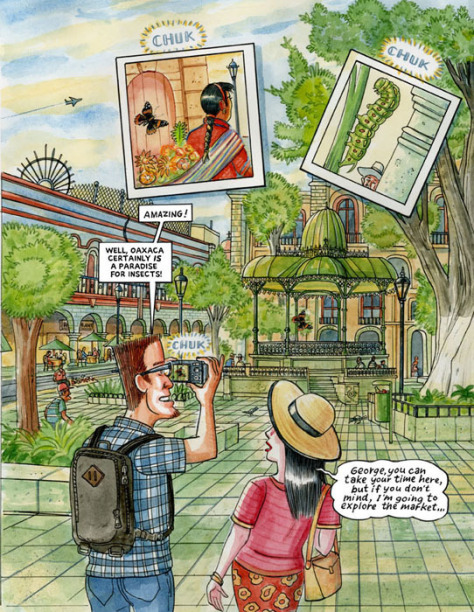
But what really makes this book stand out is not what it shows but HOW it shows it. The full color drawings are lush and complex, with a lot of deep space. Both the natural beauty and the local culture are lovingly detailed. Peter knows just what the eye wants to see and he delivers, page after page.
Some will find fault that the book does not go into the political situation in Mexico that deeply. They might even accuse Kuper of exoticizing indigenous Mexicans. But Peter never pretends to speak for the locals or to be an expert on their issues. Kuper does not try to go beyond the subjective point of view of his tourist protagonists. I think this is a good and honest decision.
The mission of our generation of cartoonists has been to elevate the comic book medium; to take this “children’s toy” and make art with it. That’s a complicated project because art is a little word that covers a vast territory. It is not only Edvard Munch and Diamanda Galas, but Norman Rockwell, Paul Gaugin, Peter Max and the Beatles. There is more than one type of art. ‘Ruins’ is not an austere modernist exploration of the medium tied to important historic events like Art Spiegelman’s ‘Maus’. It is not an introspective examination of the drudgery of everyday life, like the work of Harvey Pekar, nor is it hard-hitting on-the-ground comics journalism like Joe Sacco’s.
Peter has tried on all of those hats but in ‘Ruins’, he speaks with a voice that is uniquely his own. ‘Ruins’ tells us that nature is endangered but it is also beautiful, that indigenous people are oppressed but their culture is beautiful, that creativity is hard to achieve but its results are beautiful: that life itself is short but also beautiful. Have I said the word beautiful enough times? THIS BOOK IS FUCKING BEAUTIFUL!




